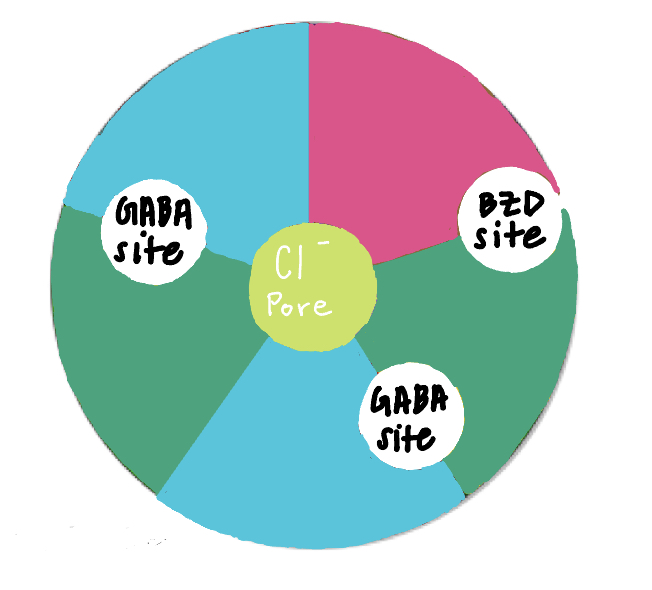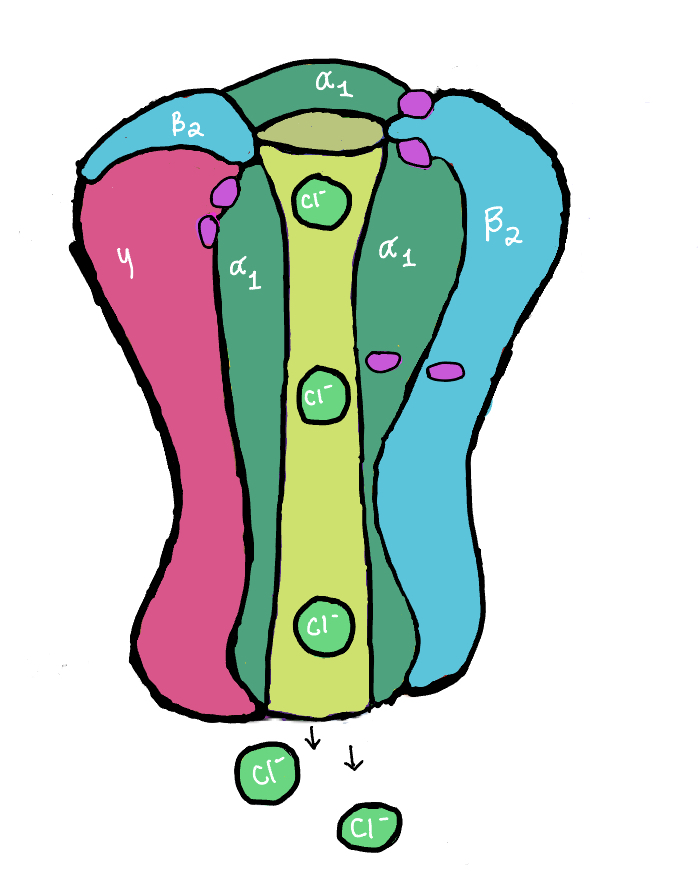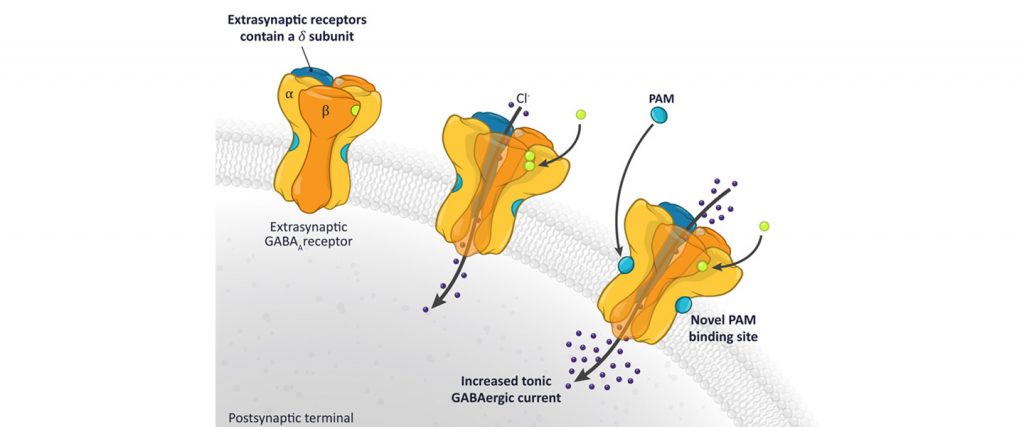One specific receptor we’re taking a look at for our project is the GABA-A receptor. This receptor is an example of a ligand-gated ion channel, and it’s function is to open up the chloride channels to the cell. Increasing the amount of chloride ions then leads to an inhibitory hyper-polarization in the cell. This receptor is also the site for many treatments of insomnia because the drugs can bind directly and allosterically inhibit GABA (19).


GABA-A receptors have two α and two β subunit as well as one γ subunit. These create a pentameric assembly of subunits with a central chloride pore as seen in Figures 1 and 2. When two GABA molecules bind to the receptor domains between the α and β subunits, and this causes a conformational change and chloride molecules are moved into the cell. This causes a hyper-polarization of the membrane which inhibits action potential firing (20).

Benzodiazepine receptor agonists interact with an allosteric recognition site at the interface alpha and gamma subunits of GABA-A receptor complex, allowing for a greater number of Cl- ions to enter the cell. Z drugs all target GABA receptor and promote higher influx of chloride ions which leads to stronger signal to sedate nervous system (21).
For additional information on the receptor site: Drugs that target GABA receptors
Overall, I think the explanation of GABAa pathway is clear and concise. However, I think if more details are added to the section, it would enhance the integrity of this section. For instance, in the second paragraph, it was mentioned that two GABA molecules bind between alpha and beta section. However, on the section it seems that each GABA receptor have two binding sites. Therefore, there seems to be four GABA molecules in total in order to cause conformational change. Additonally, what are example of GABA molecules (Tasimelteon, melatonin)? Lastly, although it was mention that hyper-polarization inhibit signal firing, what is the exact mechanism on how that work? How does the accumulation of Cl- anion interact with neurotransmitter? Does it interact with Na+ cation to prevent firing or what?
After reading the GABAT section, I realize that GABA is also a type of molecule. Therefore, I apologize for ask an example of GABA. If that is the case and if that is the main focus molecule for insomnia, what is the purpose of mentioning Tasimelteon, orexin, histamine in the answer section?
I largely agree with JP’s comments. I think it is imperative to expand upon the binding of GABA as well as the effect of high concentrations of Cl-.
We added some further explanations about the chloride channels, but we felt that explaining the details of the mechanism of how polarization works was a bit beyond the scope of our presentation
Very illustrative figures and quality information. A figure of the electrical potential of a hyperpolarization could also be good for visualization.
potentially as a figure comparing a normal firing pattern to an inhibited one when GABA is binding to its receptor.
This is a pretty detailed page and it does a good job explaining how Benzodiazepine works. I really like the figures, as they add a lot to my understanding.
A couple suggestions I have:
1) What is the importance of hyperpolarization?
2) In figure 2, I would say “top-down view” instead of “vertical view”.
3) I think under GABA subtab of “the answer” GABAa was referred to as GABA-A. It’ll be better to keep it consistent if they’re the same thing.
4) I felt like a lot of this page was repeated from the GABA subtab from the answer. That page felt really dense compared to the other briefer subtabs, so some of the information from there could be moved here instead to make the other page more easily understandable.
i agree that there was a very dense tab on GABA signaling but the rest of the website was pretty succinct. Maybe you could distribute this info across multiple pages?
I also feel that some of the GABA subtab information should be moved to this page because that page is very dense and by comparison, this one feels a little lean.
Thank you for your comments! Rather than moving our paragraphs around, we decided to link our Drugs that target GABA-A receptors page to make it easier for the reader to navigate our information and that way the reader can get more information if they need
Overall, I think the information presented in this page is great. A couple suggestions which are less content focused:
1) I would change the first sentence. The idea behind the websites is that they are academic works which could be read by anyone. I would try to contextualize GABAa’s importance within the greater themes of your website rather than arbitrarily saying that you chose to focus on it for a project.
2) The sentence beginning with “Once two GABA …” doesn’t quite make sense. I think you might have a typo.
Otherwise great job!